Q1: Define (i) electric current (ii) resistivity.
Ans: (i) Electric current is the flow of electric charges (electrons) through a conductor. It is measured as the rate at which charge flows through a point in a circuit. The SI unit of electric current is the ampere (A).
(ii)Resistivity is a property of a material that quantifies how strongly it opposes the flow of electric current. The SI unit of resistivity is ohm-meter (ΩmΩm).
Q2: Sketch a circuit diagram of an electric circuit consisting of a cell, an electric bulb, an ammeter, a voltmeter and a plug key.
Ans:
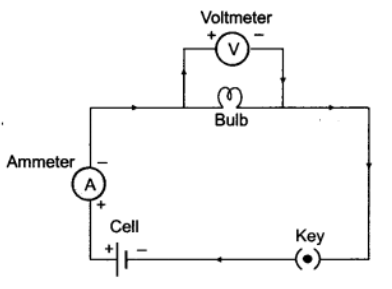
Q3: State Ohm’s law.
Ans: Ohm’s law states that the current flowing through a conductor is directly proportional to the potential difference across its ends, provided the temperature remains constant. It is expressed as V=IR where:
- V= Potential difference (volts)
- I = Current (amperes)
- R = Resistance (ohms)
Q4: What is a parallel circuit and series circuit ?
Ans: In a parallel circuit, components are connected across the same two points, so each component has the same potential difference across it. The total resistance in a parallel circuit is less than the resistance of any individual branch.
In a series circuit, components are connected end-to-end so that the same current flows through each component. The total resistance is the sum of the individual resistances, and the potential difference is divided among the components.
Q5: Should the resistance of an ammeter be low or high? Give reason.
Ans:The resistance of an ammeter should be low so that it will not disturb the magnitude of current flowing through the circuit when connected in series in a circuit.
Q6: How does use of a fuse wire protect electrical appliances?
Ans: The fuse wire is always connected in series with the live wire or electrical devices. If the flow of current exceeds the specified preset value due to some reason, the heat produced melts it and disconnects the circuit or the device from the mains.
In this way, fuse wire protects the electrical appliances.
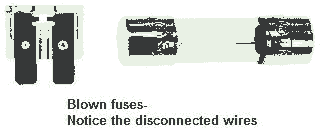 Q7: What factors affect the resistance of a conductor?
Q7: What factors affect the resistance of a conductor?
Ans: Resistance depends on:
- Length of the conductor ()
- Cross-sectional area ()
- Nature of the material
- Temperature
Q8: What is electrical resistivity? In a series electrical circuit comprising a resistor made up of a metallic wire, the ammeter reads 5 A. The reading of the ammeter decreases to half when the length of the wire is doubled. Why?Ans: The resistance offered by a metallic wire of unit length and unit cross-sectional area is called electrical resistivity.

Hence, when the length of wire is doubled, the resistance becomes double and current decreases to half.
Q9: A copper wire of resistivity 2.6 × 10-3 Ωm, has a cross sectional area of 30 × 10-4 cm3. Calculate the length of this wire required to make a 10 Ω coil.
Ans: Given: R = 10Ω, ρ = 2.6 × 10-8 Ωm,
To find: l = ?
Formula: R = ρlA
Solution: R = ρlA
∴ ρl = RA

Q10 : Why is parallel arrangement used in domestic wiring?
Ans: Parallel arrangement is used in domestic wiring because
- Each appliance gets the same voltage as that of the mains supply.
- If one component is switched off, others can work properly.
- Fault in any branch of the circuit can be easily identified.

Q11: Three 2 Ω resistors, A, B and C are connected as shown in figure. Each of them dissipates energy and can withstand a maximum power of 18 W without melting. Find the maximum current that can flow through the three resistors.
Ans:
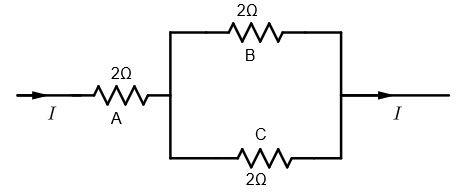 Here, P = 18 W
Here, P = 18 W
Since A is in series with the parallel combination of B and C. So, it carries maximum current.

Let IB and IC be the current flowing through B and C respectively. As they are in parallel, potential difference across them will be same, so
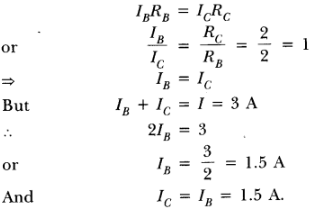
Q12: Nichrome wire is used for making the Ideating elements of electrical appliances like iron, geyser, etc. Give reasons.
Ans: Nichrome wire is used for making the heating elements of electrical appliances like iron, geyser, etc. because:
- Nichrome has a very high resistance due to which it produces a lot of heat on passing current.
- It does not undergo oxidation easily even at high temperature due to which it can be kept red hot.
Q13: A current of 1 ampere flows in a series circuit containing an electric lamp and a conductor of 5 Ω when connected to a 10 V battery. Calculate the resistance of the electric lamp.
Now if a resistance of 10 Ω is connected in parallel with this series combination, what change (if any) in current flowing through 5 Ω conductor and potential difference across the lamp will take place? Give reason.
Ans: Given: In series circuit containing lamp and resistor,
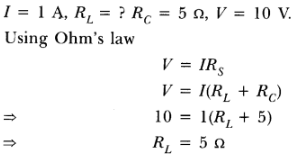
So, resistance of an electrical lamp is 5Ω.
According to the given condition, circuit can be redrawn as shown.
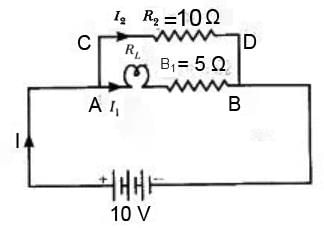 So, effective resistance of parallel combination.
So, effective resistance of parallel combination.
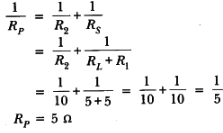
Current drawn form the battery

As in parallel combination potential difference across them remains same, So
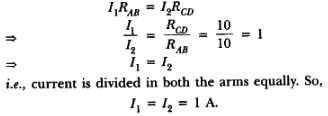
Hence, there will be no change in the current through 5Ω conductor. Also there will be no change in the potential difference across the lamp as in both cases, current through the lamp remains same i.e. 1A.
Q14: State the relation between work, charge and potential difference for an electric circuit. Calculate the potential difference between the two terminals of a battery if 100 joules of work is required to transfer 20 coulombs of charge from one terminal of the battery to the other.
Ans: V = W/Q
Here,
V = Potential difference,
W = Work done,
Q = Electric charge
W = 100 J
Q = 20 C
V = WQ=10020 = 5V
Q15: B1, B2 and B3 are three identical bulbs connected as shown in figure. When all the three bulbs glow, a current of 3A is recorded by the ammeter A.
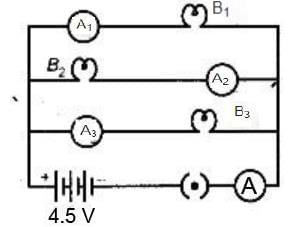 (i) What happens to the glow of the other two bulbs when the bulb B j gets fused?
(i) What happens to the glow of the other two bulbs when the bulb B j gets fused?
(ii) What happens to the reading of A1 ,A2 , A3 and A when the bulb B2 gets fused?
(iii) How much power is dissipated in the circuit when all the three bulbs glow together?
Ans: (i) Since B1 ,B2 and B3 are in parallel, the potential difference across each of them will remain same. So when the bulb B1 gets fused, B2 and B3 have the same potential and continues with the same energy dissipated per second, i.e. they will glow continuously as they were glowing before.
(ii) Resistance of the parallel combination when all the three bulbs are glowing

Ammeter 'A' reads 3 A current

So, resistance of each bulb = 4.5 Ω.
Now when bulb B2 gets fused, the equivalent resistance of parallel combination of B1 and B3 is

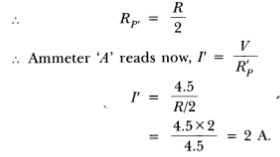
Since resistance of each arm is same and p.d. is also same, current divides them equally. So 1 A current will pass through each bulb B1 and B3.
Therefore, ammeter A1 and A3 reads 1 current while A2 will read zero and ammeter A read 2 A current
(iii)
In parallel. total power consumed

So, when all the three bulbs glow together

Q16: With the help of a diagram, derive the formula for the equivalent resistance of three resistances connected in parallel.
Ans: 1. If a number of resistances are connected between two common points in such a way that the potential difference across each resistance is same, then the arrangement is called ‘Resistances in Parallel’.
2. Let R1, R2 and R3 be the three resistances connected in parallel combination between points C and D and let Rp be their equivalent resistance.
Let I1, I2 and I3 be the currents flowing through resistances R1, R2 and R3 respectively.
Let I be the current flowing through the circuit and V be the potential difference of the cell.
3. According to Ohm’s law.
I = V/R
Therefore,
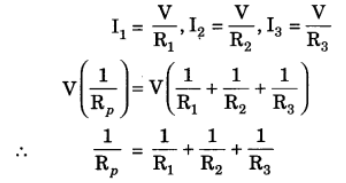
Therefore, the reciprocal of the equivalent resistances in parallel combination is equal to the sum of the reciprocals of the individual resistances.
Q17: Three incandescent bulbs of 100 W each are connected in series in an electric circuit. In another circuit, another set of three bulbs of the same wattage are connected in parallel to the same source.
(а) Will the bulb in the two circuits glow with the same brightness? Justify your answer.
(b) Now let one bulb in both the circuits get fused. Will the rest of the bulbs continue to glow in each circuit? Give reason.
Ans: For three identical bulbs,
In series, RS = 3R
In Parallel, Rp = R/3.
(a) The bulbs in the two circuits will not glow equally bright as the current through them is not the same.
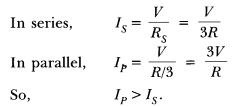
(b) As one bulb fuses, the other bulbs in the series circuit will not glow because the circuit becomes an open circuit.
While the rest of bulbs in parallel circuit will continue to glow without getting disturbed because in parallel combination, current gets additional paths to flow.
Q18: Find out the following in the electric circuit given in figure:
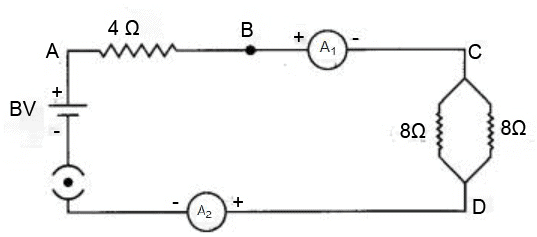
Ans:(a) Effective resistance, the two 8Ω resistors in parallel,

(b) Req = 4 + Rp = 8Ω
So current through 4Ω 
(c) Potential difference across resistance 4Ω = V1 = IR = 1 * 4 = 4 V
(d) Power dissipated = I2R = I2 * 4 = 4 W
(e) No difference, since the ammeters are connected in series and the same current will pass through them, so the reading of both ammeters will be the same.
Q19: An electric lamp, whose resistance is 20 Ω, and a conductor of 4 Ω resistance are connected to aft V battery (Fig.).
Calculate (a) the total resistance of the circuit, (b) the current through the circuit, and (c) the potential difference across the electric conductor.
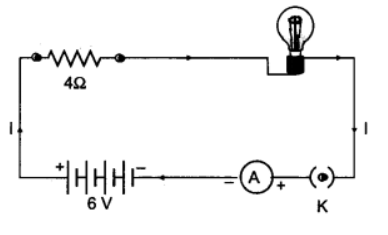
Ans: (a) Resistance of electric lamp, R1 = 20 W
Resistance of series conductor, R2 = 4 W
Total resistance in the circuit,
Rs = R1 + R2 = 20 Ω + 4 Ω = 24 Ω.
(b) Total potential difference, V = 6 V
By Ohm’s law, the current through the circuit is

(c) Potential difference across the electric lamp,
V1 = IR1 = 0.25 A × 20 Ω = 5 V.
Potential difference across the conductor is
V2 = IR2 = 0.25 A × 4 Ω = 1 V.
Q20: If, in Figure R1 = 10 ohms, R2 = 40 ohms, R3 = 30 ohms, R4 = 20 ohms, Rg = 60 ohms and a 12 volt battery is connected to the arrangement, calculate: (a) the total resistance and (b) the total current flowing in the circuit.
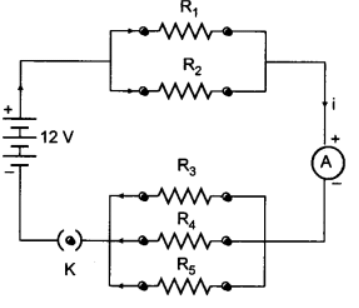
Ans: (a) Let R’ be the equivalent resistance of R1 and R2. Then,

R’ = 8Ω
Let R” be the equivalent resistance of R3, R4 and R5. Then,

R” = 10 Ω
Total Resistance, R = R’ + R” = 8 + 10 = 18 Ω
(b) Current,

Q21: Two lamps, one rated 60 W at 220 V and other 40 W a 220 V, are connected in parallel to an electric supply at 220 V.
(a) Draw the circuit diagram to show the connections.
(b) Calculate the current drawn from the electric supply.
(c) Calculate the total energy consumed by the two lamp together when they operate for one hour.
Ans: (a) The required circuit diagram is shown below:
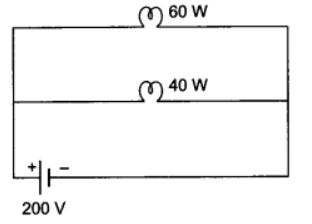
(b) Total power of the two lamps = 60 + 40 = 100 W
Applied Voltage, V = 220 V
Current drawn from the electric supply,

(c) Total energy consumed by the lamp in one hour = 60W × 1h + 40W × 1h = 100 Wh = 0.1 kWh.
Q22: Differentiate between Resistance and Resistivity.
Ans: Resistance:
- It is the opposition provided by the atoms of a conductor to the flow of electrons.
- SI unit of resistance is Ω (Ohm).
- Resistance depends on length, area of cross section, material and temperature of conductor.
Resistivity:
- It is the resistance of the conductor of that substance of unit length and unit area of cross section.
- SI unit of Resistivity of Ωm (Ohm-meter).
- Resistivity of substance depends only on the material of substance.
 Q7: What factors affect the resistance of a conductor?
Q7: What factors affect the resistance of a conductor?












 (i) What happens to the glow of the other two bulbs when the bulb B j gets fused?
(i) What happens to the glow of the other two bulbs when the bulb B j gets fused?




































